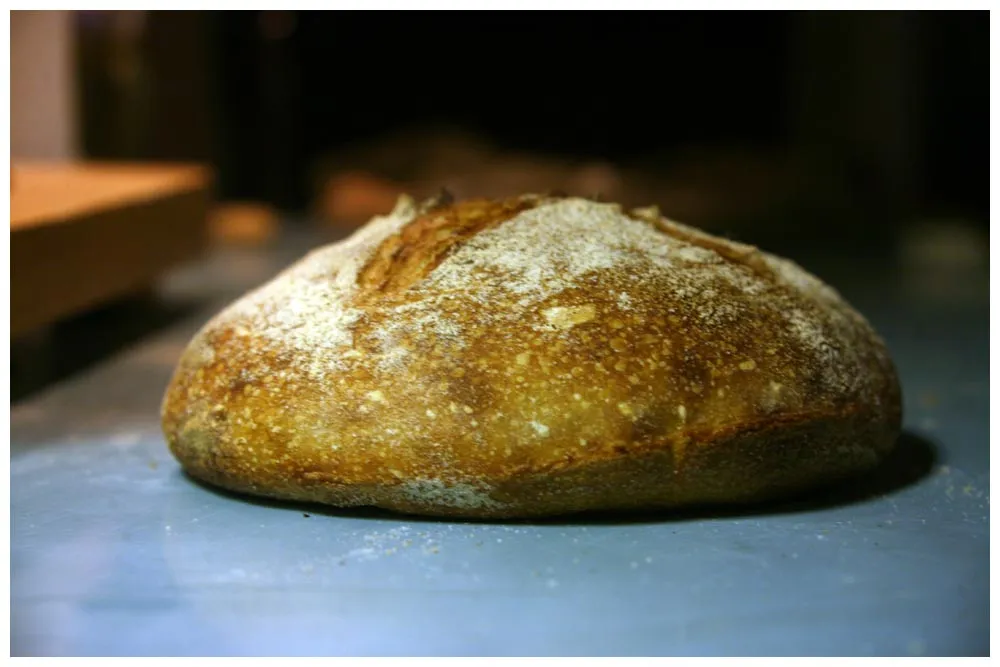
The last two loaves I baked following the Tartine recipe have tasted great, but looked weak. Wondering if the weak edges (not round, but more pancake) and minimal oven spring are the result of poor shaping on my part or overproofing or something else? This loaf was 75% hydration, 5 hours bulk ferment (good air bubbles) and second rise of 4.5 hours. Any help would be appreciated.
-Glen
Can we see a crumb photo to help us diagnose. I've yet to try the tartine loaf (well making it, i have eaten it once) but with a photo of the inside we can learn more. Also a touch more info. How are you baking it? temperature? stone? dutch oven?
Josh
How much is the dough rising during the 5 hour bulk ferment? Stretch and folds?
Thanks Josh!
I baked it in a dutch oven preheated to 500F and then lowered to 450F. As far as the bulk fermentation, it is tough to say in a bowl, but I would guess around 20%. I folded 4 times in the 2 hours and then was out running errands for the next 3 so no more folds after 2 hours. I'll post a crumb pic once we cut into this morning.
Glen
Could be shaping or too few stretch and folds (or not enough pulling/stretching during stretch and folds). Could also be that the dutch oven is too large to give this wet dough enough support on the sides.
Bowls are massivley decieving when trying to determine how much a dough has risen. Just keep this in mind.
After talking to a professional baker, I am starting to think I overproofed. I just realized that when my bread was proofing in the oven, my wife made lunch for my daughter on the stove top thus ratcheting up the temp inside the oven to the 90's. Could this have been the cause? Is the bulk fermentation done when you first start to see bubbles? Still a little cloudy on when you know it is done. Thanks again guys.
-Glen
If your shaped final proof was 4.5 hours with temps in the 90Fs, seems like it could have easily been overproofed. When I make a Tartine-style bread, my final proof is generally 2-2.5 hrs at 78F. If you get in the habit of gently poking the bread as it approaches the end of proofing, you'll develop a sense of when to bake. A small indent should spring back slowly when the time is right.
Less likely but stil possible is that some of the yeast died off from overly warm temps during proofing. Sourdough yeast are much more delicate than commerical yeast and have been shown to begin dying off at 90F+. I try to keep temps to 85F or less.
re: how long to bulk ferment, this is a question of flavor- I stretch and fold during the first 3-4 hours (when I'm expecting a 5.5 - 6 hour ferment) and then leave the dough alone for the rest of the time so I can use volume as my guide for when the fermentation is enough. A dough that rises to double its original volume is fine, any less than that and you'll need to compensate by extending the final proof a bit. My favorite flavor is at about 2.25x - 2.5x volume, and this is what I normally shoot for. By the time the dough triples in volume, it is getting a bit too ripe and/or sour for my taste.
The nice thing about using volume to gauge the bulk ferment is that it doesn't matter what proportion of sourdough starter you've used. If you used a higher proportion, the bread will have more acid in its flavor but still be ready at about 2-2.5x volume (this might only take 2-3 hours). If you used a lower proportion of starter (i.e., Tartine-style), it will have less acid but still be ready at the same volume (this might take 5-7 hours, depending on temp, etc.).